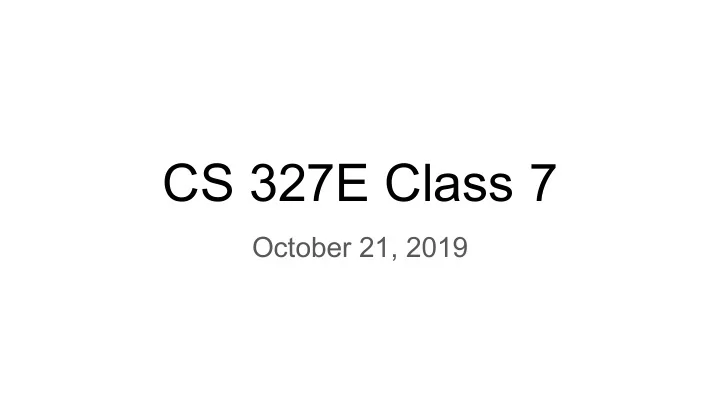

CS 327E Class 7 October 21, 2019
Announcements ● Midterm is next class from 6pm - 7:30pm ● Midterm location: Mary E Gearing Hall, GEA 105 ● Review session: Friday from 1pm - 2pm in GDC 1.304 ● Milestone 7 due this Friday.
1) Which is not an aggregate function? A. SUM() B. COUNT(*) C. AVG() D. MIN() E. None of the above
2) Consider the Women_Soccer_2019 table shown below. What is the output from Q1 when run on this table? Q1: SELECT COUNT(*) FROM Women_Soccer_2019 xxxxWHERE position IN ('M', 'D') A. 0 B. 9 C. 7 D. 4 E. 3
3) Consider the Women_Soccer_2019 table shown below. What is the output from Q2 when run on this table? Q2: SELECT MIN(goals) FROM Women_Soccer_2019 xxxxWHERE position IN ('M', 'D') A. 0 B. 9 C. 7 D. 3 E. 1
4) Consider the Women_Soccer_2019 table shown below. What is the output from Q3 when run on this table? Q3: SELECT MAX(goals) FROM Women_Soccer_2019 xxxxWHERE height = '5-9' A. 10 B. 9 C. 7 D. 3 E. 1
5) Consider the Women_Soccer_2019 table shown below. What is the output from Q4 when run on this table? Q4: SELECT SUM(goals) FROM Women_Soccer_2019 xxxxWHERE position = 'M' OR position = 'D' A. 10 B. 9 C. 7 D. 3 E. 1
Syntax of Global Aggregate Queries SELECT <aggregate functions> FROM <single table> JOIN <single table> ON <join condition> WHERE <boolean condition>
Syntax of Aggregate Queries with Groups SELECT <unaggregated fields> FROM <single table> ... GROUP BY <unaggregated fields>
Syntax of Aggregate Queries with Groups SELECT <unaggregated fields>, <aggregate functions> FROM <single table> JOIN <single table> ON <join condition> WHERE <boolean condition> GROUP BY <unaggregated fields> HAVING <boolean condition> ORDER BY <fields to sort on>
How COUNT() works Employee 1) SELECT COUNT(*) FROM Employee 2) SELECT COUNT(emp_dept) FROM Employee 3) SELECT COUNT(DISTINCT emp_dept) FROM Employee
First Question Student(sid, fname, lname, dob) Class(cno, cname, credits) How many students are taking Teacher(tid, fname, lname, dept) each class? Takes(sid, cno, grade) Teaches(tid, cno)
Second Question Student(sid, fname, lname, dob) For each class with at least Class(cno, cname, credits) two students in it, Teacher(tid, fname, lname, dept) how many students are Takes(sid, cno, grade) taking such a class? Teaches(tid, cno)
iClicker Question Student(sid, fname, lname, dob) Class(cno, cname, credits) For each class with at least Teacher(tid, fname, lname, dept) two students in it, Takes(sid, cno, grade) how many students are Teaches(tid, cno) taking such a class? Does this query require a HAVING clause? A. Yes B. No
Third Question Student(sid, fname, lname, dob) For each student who is at least Class(cno, cname, credits) 19-years old and is earning Teacher(tid, fname, lname, dept) more than 2 class credits, Takes(sid, cno, grade) how many total class credits Teaches(tid, cno) are such students earning?
iClicker Question Student(sid, fname, lname, dob) For each student who is 19-years Class(cno, cname, credits) old or above and is earning at least Teacher(tid, fname, lname, dept) 3 class credits, how many total class Takes(sid, cno, grade) credits are such students earning? Teaches(tid, cno) Does this query require a WHERE clause? A. Yes B. No
Fourth Question Student(sid, fname, lname, dob) Who takes exactly 3 classes? Class(cno, cname, credits) Teacher(tid, fname, lname, dept) Show the answer as a sorted Takes(sid, cno, grade) list of sids. Teaches(tid, cno)
iClicker Question Student(sid, fname, lname, dob) Class(cno, cname, credits) Who takes exactly 3 classes? Teacher(tid, fname, lname, dept) Takes(sid, cno, grade) Show the answer as a sorted Teaches(tid, cno) list of sids. Does this query contain an aggregate function in the SELECT clause? A. Yes B. No
Database Views Defined by CREATE VIEW statement • • Return a table of results from a SQL query • Saved in the database as named query Employee(empid, fname, lname, role, level, start_date, curr_salary, dob, ssn, emergency_contact) CREATE VIEW Director_View AS SELECT empid, fname, lname SELECT empid, fname, lname, role, level, start_date, curr_salary FROM Director_View FROM Employee WHERE start_date > '2018-04-23' WHERE level != 'Executive' AND role = 'Data Engineer' ORDER BY empid
Example Views CREATE VIEW Director_View AS SELECT empid, fname, lname SELECT empid, fname, lname, role, level, start_date, curr_salary FROM Director_View FROM Employee WHERE start_date > '2018-04-23' WHERE level != 'Executive' AND role = 'Data Engineer' ORDER BY empid SELECT empid, fname, lname CREATE VIEW Manager_View AS FROM Manager_View SELECT empid, fname, lname, role, level, start_date, curr_salary WHERE curr_salary > 200000 FROM Director_View AND level = 'Director' WHERE level != 'Director' ORDER BY empid
Demo: Views and Data Studio • Create Views in BigQuery • Query Views in BigQuery • Create Data Sources in Data Studio • Create Report and Charts in Data Studio Referenced code: https://github.com/cs327e-fall2019/snippets/blob/master/create_views.sql
Milestone 7 http://www.cs.utexas.edu/~scohen/milestones/Milestone7.pdf
Recommend
More recommend